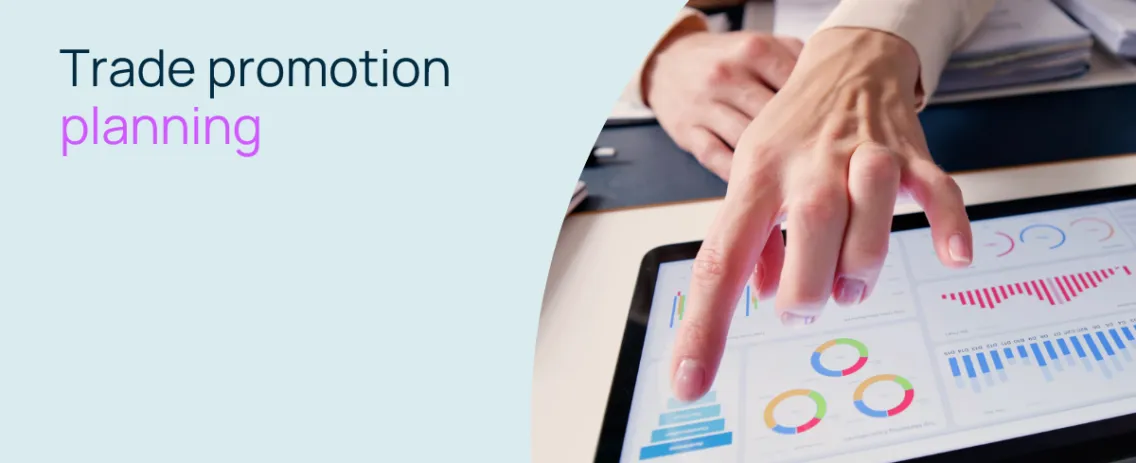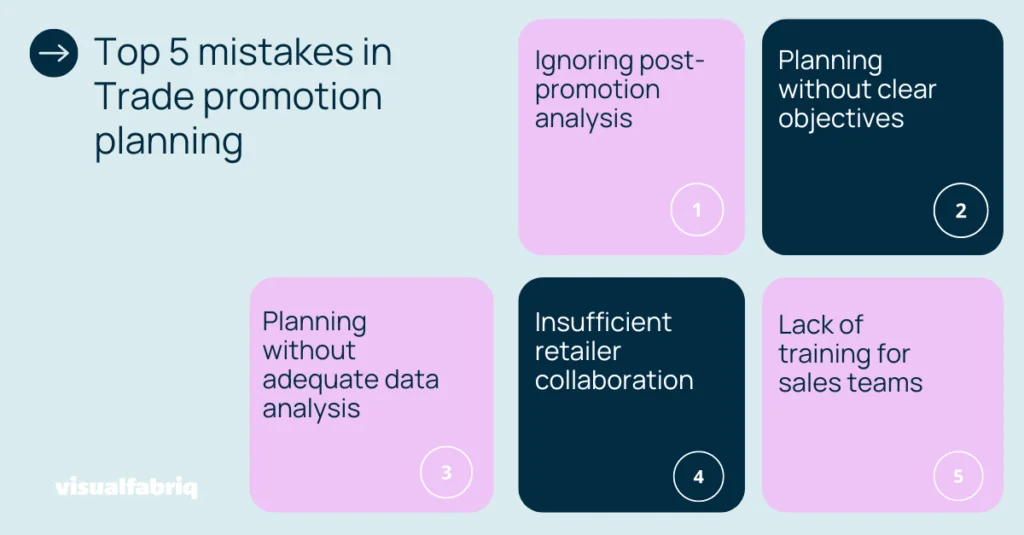
Trade promotion planning: The top 5 mistakes CPG teams make
In the consumer-packaged goods (CPG) industry, trade promotion planning is about more than tactics – it requires a solid, data-driven strategy to be successful. Effective trade promotions planning can significantly drive sales, increase market share, and enhance brand visibility. However, navigating this complex process is fraught with challenges that can impede a team’s performance and results.
Many sales teams encounter common pitfalls that can undermine their promotional efforts. Recognizing and avoiding these mistakes is crucial for any team aiming to maximize the impact of their trade promotion strategies.
This blog post highlights the top five mistakes made in trade promotion planning within the CPG industry.

1. Ignoring post-promotion analysis
In the fast-paced CPG world, sales teams are often quick to move from one trade promotion to the next. However, neglecting to analyze the outcomes of these promotions can leave teams without a clear understanding of what strategies were successful and which fell flat.
Without a post-promotion review, CPG teams are virtually driving blind. They cannot objectively identify key success factors and areas that require improvement. This lack of insight is likely to lead to a cycle of repeated errors and overlooked opportunities for optimization.
The impact
The repercussions of skipping post-promotion analysis are significant. Teams risk repeating unsuccessful strategies, for example, or squandering resources. They may also fail to leverage the successful elements of past campaigns, which could have been replicated or scaled for better results.
Best practices
To avoid these pitfalls, it’s crucial for CPG teams to conduct a thorough post-mortem analysis after each trade promotion. Key metrics to consider include sales lift, incremental volume, and return on investment (ROI).
Action steps
CPG teams should develop a standardized framework for evaluating the effectiveness of promotions. This framework should focus on capturing insights from past promotions. And then integrating these learnings into your future trade promotion planning process. By doing so, teams can continuously refine their trade promotion strategies, optimizing while planning to ensure better outcomes with each campaign.
2. Planning trade promotions without clear objectives
Planning trade promotions without well-defined, measurable objectives is akin to navigating without a compass. This approach leads to uncertainty in both execution and evaluation, making it difficult to determine the true effectiveness of the promotion.
Broad objectives such as “increase sales” lack the specificity needed to drive focused action. Clear, quantifiable goals on the contrary provide a roadmap for the team, ensuring that everyone is aligned and understands the targets they are trying to hit.
The impact
The absence of clear objectives often results in ineffective promotions, with efforts that are misaligned. It also causes a significant challenge in measuring the success of the promotional activities.
Best practices
To circumvent these issues, it’s imperative to set SMART goals that are Specific, Measurable, Achievable, Relevant, as well as Time-bound.
Action steps
Teams should articulate precise targets, such as aiming for a “10% increase in sales over the next quarter,” or “growing market share in a specific region by 5%.” These clear targets then serve as benchmarks for success and help in steering the promotional efforts in the right direction.
3. Trade promotion planning without adequate data analysis
When it comes to planning trade promotions, decisions grounded in solid data analysis are the bedrock of success. However, when teams fail to thoroughly analyze historical data and market trends, they risk basing their decisions on guesswork rather than facts.
The reliance on assumptions, rather than hard data, can lead to promotions that are out of sync with the target audience’s needs and shifting market conditions. This disconnect may result in promotions that do not resonate with consumers or fail to address the competitive landscape effectively.
Moreover, the complexity of manually combining multiple data sources adds to the challenge. Teams often find themselves grappling with disparate data sets, trying to piece together a coherent picture. This not only consumes valuable time but also increases the likelihood of errors. An automated solution on the other hand streamlines this process, ensuring that data from various sources is integrated seamlessly. It provides a reliable foundation for informed decision-making and successful trade promotions.
The impact
A lack of focus on data analysis can result in inefficient allocation of promotional budgets. It can also lead to targeting that misses the mark, and promotions that fall short of consumer expectations or fail to counteract competitors’ moves.
Best practices
To mitigate these risks, it’s essential to leverage advanced data analytics throughout the trade promotion planning process.
Action steps
Teams should integrate a variety of data sources, including sales figures, consumer insights, and competitive analysis, to forge promotional strategies that are informed by data. Investing in analytical tools that offer real-time insights and predictive capabilities can significantly enhance the effectiveness of the trade promotion planning process.
.png?width=904&height=226&name=The%20CPG%20Executive%E2%80%99s%20Guide%20to%20Advanced%20TPx%20(2).png)
4. Insufficient retailer collaboration when planning trade promotions
Collaboration with retailers is a cornerstone of successful trade promotions, but it is often overlooked. Without retailers’ involvement in the planning process, promotions may suffer from misaligned execution and lackluster performance.
Retailers are pivotal in ensuring the success of trade promotions. A disconnect in communication and collaboration can lead to ineffective in-store execution and a reduced impact of the promotional efforts.
The impact
Neglecting retailer collaboration can lead to diminished effectiveness of promotions, missed opportunities for sales, and potential harm to retailer relationships.
Best practices
Cultivating strong win-win partnerships with retailers is key. This involves bringing them into the fold early in the planning stages to ensure their buy-in and support. Additionally, a good understanding of and insight into retailer margins is crucial for CPG companies. Only by having a clear picture of the retailer’s financial expectations and constraints, can CPGs position themselves as equals in the conversation about the promotional plan. This knowledge makes for easier negotiations as well as more effective trade promotions, as both parties can work towards mutually beneficial outcomes with full transparency. To fully grasp retailer margins and negotiate effectively, a software solution is essential. It simplifies data collection and analysis, providing clear insights for strategic planning.
Action steps
Engage in regular dialogue with retailers to communicate promotional strategies and solicit their input. Then tailor promotions to align with the retailers’ capabilities and objectives, which helps guarantee a smooth and successful execution.
5. Lack of training and support for sales teams
The effectiveness of trade promotions heavily relies on the sales teams’ ability to execute them. However, without adequate training and support, these teams may find themselves ill-equipped to carry out their roles effectively.
It’s crucial for sales teams to have a deep understanding of the promotion’s mechanics, objectives, and strategies for execution. Insufficient training can lead to inconsistent application across different teams and missed opportunities to capitalize on the promotion.
As the promotional landscape evolves, software plays an increasingly significant role. While software offers essential support in trade promotion management, its full potential is only unlocked when sales teams are properly trained to use it. Comprehensive training, therefore, is necessary to ensure that teams can leverage the software to its fullest.
The impact
The lack of proper training and support can result in uneven execution of promotions, poor engagement with retailers, and an overall decrease in the effectiveness of the trade promotion strategy.
Best practices
Investing in thorough training programs is essential. These programs should provide sales teams with the necessary knowledge and tools to succeed.
Action steps
Consider engaging with specialized training programs to enhance the skills and knowledge of sales teams, ensuring they are fully prepared to implement trade promotions successfully.
Avoiding common mistakes with Visualfabriq
Visualfabriq offers a comprehensive SaaS solution designed to help navigate the common pitfalls encountered in trade promotion planning. With its integrated approach, Visualfabriq empowers teams to execute promotions with precision and confidence.
To stay up to par with industry best practices, combining the use of such software with robust training programs, like the Get Trained Bootcamp by Visualfabriq, is essential. This ensures that teams not only have the best tools at their disposal but also the know-how to use them effectively.
Throughout our exploration of trade promotion planning, we’ve uncovered a series of common mistakes that can hinder the success of promotional activities. From unclear objectives to inadequate data analysis, insufficient retailer collaboration, and lack of support for sales teams, these pitfalls can significantly impact the effectiveness of trade promotions.
Key recommendations:
- Analyze tops and flops, and identify key promotional success factors
- Establish clear, SMART objectives to guide promotional efforts.
- Leverage advanced data analytics for forecasting and promotion optimization
- Collaborate closely with retailers to align execution strategies.
- Provide comprehensive training and support to sales teams.
We encourage sales teams to embrace these strategies and consider Visualfabriq as the premier solution for enhancing their trade promotion planning process. By adopting Visualfabriq’s integrated approach, teams can not only avoid common mistakes but also ensure that their trade promotions are highly effective.
For a deeper dive into how Visualfabriq can transform your trade promotion strategy, we invite you to download our informative software brochure and request a demo to see the solution in action.

.png)
.png)
.png)